
Petone is a large suburb of Lower Hutt, Wellington. It stands at the southern end of the Hutt Valley, on the northern shore of Wellington Harbour.

Lambton Quay is the heart of the central business district of Wellington, the capital city of New Zealand.

Oriental Bay is a bay and suburb of Wellington, the capital city of New Zealand. Known for being both a popular beach and an opulent centre of affluence in the city, it is located close to the central business district on Wellington Harbour.

The Wellington Cathedral of St Paul, also called St Paul's Cathedral or Wellington Cathedral, is an Anglican cathedral church located on Hill Street, at its junction with Molesworth Street, in Thorndon, in the city of Wellington, New Zealand. It is situated close to the parliament precinct.
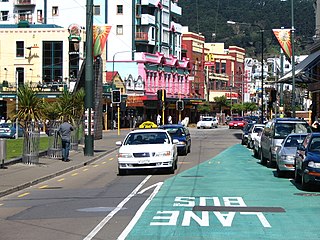
Te Aro is an inner-city suburb of Wellington, New Zealand. It comprises the southern part of the central business district including the majority of the city's entertainment district and covers the mostly flat area of city between The Terrace and Cambridge Terrace at the base of Mount Victoria.
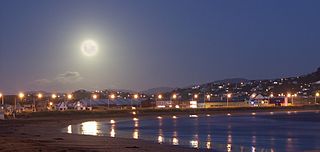
Lyall Bay is a bay and suburb on the south side of the Rongotai isthmus in Wellington, New Zealand.
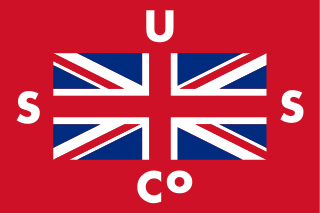
Union Steam Ship Company of New Zealand Limited was once the biggest shipping line in the southern hemisphere and New Zealand's largest private-sector employer. It was incorporated by James Mills in Dunedin in 1875 with the backing of a Scottish shipbuilder, Peter Denny. Bought by shipping giant P&O around the time of World War I it was sold in 1972 to an Australasian consortium and closed at the end of the twentieth century.
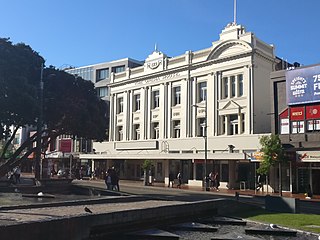
The Opera House is a proscenium theatre in Wellington, New Zealand, located on Manners Street opposite Te Aro Park.

The Dominion Museum building on Mount Cook in Buckle Street Wellington completed in 1936 and superseded by Te Papa in 1998 was part of a war memorial complex including a Carillon and National War Memorial.

Steeple Rock/Te Aroaro-o-Kupe is a large rock off Seatoun at the west of the entrance to Wellington Harbour, rising 7 metres (23 ft) above sea level. The rock plays a role in warning ships off the coast. It is the location of a marine light and an unbeaconed trig station.

Kirkcaldie & Stains was a department store in Wellington, New Zealand. It was established in 1863 by John Kirkcaldie and Robert Stains with a capital of £700. The first store was opened on Lambton Quay. In 1868 Kirkcaldie & Stains moved to their final location at the corner of Lambton Quay and Brandon Street, expanding several times. There was a branch on Cuba Street, Wellington from 1870 –1876 and one in Napier from 1897 until 1917. French luxury skincare brand Sisley was exclusive to the store in New Zealand.

Star Boating Club is a Wellington based rowing club, situated on the waterfront adjacent to Whairepo Lagoon. It is the oldest rowing club in Wellington, having existed since 1866. Star is one of New Zealand's oldest active rowing clubs and sporting organisations. It is home to rowers of all ages.

The Old Bank Arcade is a retail and office complex on a corner site at Lambton Quay, Wellington, New Zealand.
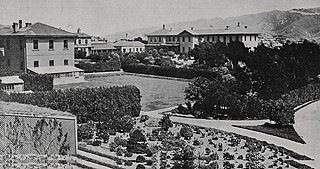
The Mount View Lunatic Asylum was a psychiatric hospital located on 113 acres (46 ha) near the Basin Reserve in Wellington, New Zealand. Government House is now located on what were the asylum grounds. Work began in 1872, and the hospital opened in May 1873. It replaced Karori Lunatic Asylum, the first asylum in the country. Mount View was planned to accommodate 28 male and 28 female patients, but as 70 patients were transferred from Karori, overcrowding was a problem from the beginning. An expansion was required soon after the asylum opened to accommodate more patients, so in 1879 the two-storey wooden structure was enlarged with a block for 50 male patients, and another wing was built during 1880. Around 1885 two additional wards were constructed. By 1905 there were 250 patients but within the next five years, they were transferred to Porirua Lunatic Asylum and other asylums, before Mount View's closure in 1910.
Robert Stokes practised briefly as an architect in England in the 1830s before emigrating to New Zealand, where he had a varied career as a land surveyor, a newspaper proprietor and latterly as a member of the New Zealand Legislative Council. The Lower Hutt suburb of Stokes Valley in New Zealand commemorates his name.

Roseneath is a suburb of Wellington, New Zealand, located east of Oriental Bay and north of Hataitai. The peninsula was named after Rosneath, a village on the Rosneath Peninsula on Scotland's River Clyde, and has no association with roses.

William Turnbull was an architect based in Wellington, New Zealand. He was the fourth and youngest son of architect Thomas Turnbull. He joined his father's practice in 1882 and became a partner in 1891. He was born in San Francisco where his father was working at the time. He moved to New Zealand with his family in 1871. In his younger years, he played rugby union at Poneke Football Club in Kilbirnie.
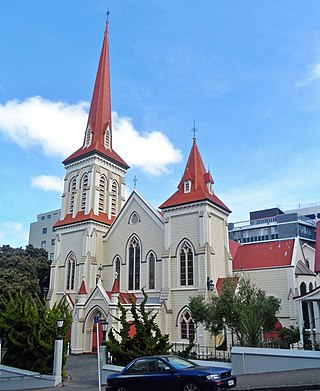
St John's Church in Willis Street, Wellington, New Zealand, is registered by Heritage New Zealand as a Category 1 Historic Place. Designed by Thomas Turnbull, it opened on 11 December 1885 to replace an earlier church destroyed by fire in 1884. It was registered as a historic place on 18 March 1982, with registration number 228.

McGavin House, also known as the former Red Cross Building, is a building in Wellington, New Zealand, classified as a Category 1 Historic Place by Heritage New Zealand.

Whitmore Street is at the boundary of the central business district and the government buildings area of Wellington, New Zealand's capital. The street runs almost north-south and is one of those linking Lambton Quay, Wellington's main shopping street, with Stout Street, Featherston Street and the harbourside at Customhouse/ Waterloo Quay. It is in the suburb of Pipitea.




































